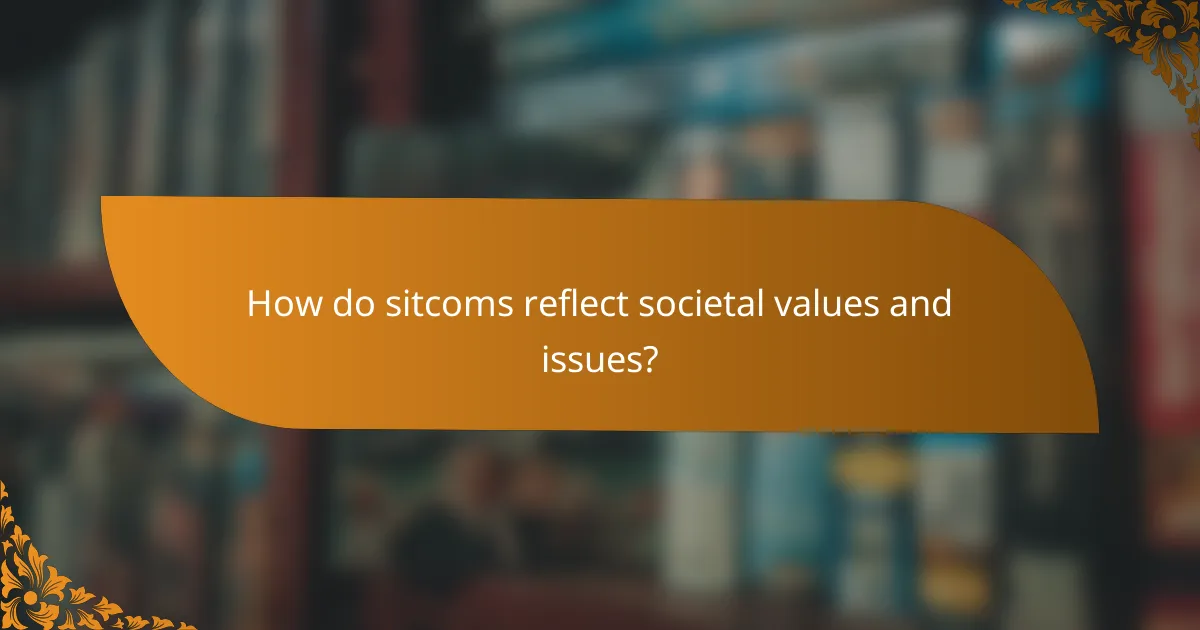
What defines the evolution of sitcoms?
The evolution of sitcoms is defined by changes in humor, societal norms, and character dynamics. Initially, sitcoms focused on family-centric narratives and light-hearted humor. Shows like “I Love Lucy” set the foundation in the 1950s. Over time, sitcoms began to reflect societal issues, as seen in “All in the Family.” The 1980s and 1990s introduced diverse characters and complex storylines, exemplified by “Friends” and “The Fresh Prince of Bel-Air.” Recent sitcoms often blend humor with social commentary, like “Brooklyn Nine-Nine.” This evolution showcases how sitcoms adapt to cultural shifts while maintaining comedic elements.
How have sitcoms changed over the decades?
Sitcoms have evolved significantly over the decades in terms of humor, themes, and character dynamics. In the 1950s, sitcoms often featured idealized family structures and traditional gender roles. Shows like “I Love Lucy” focused on domestic life and slapstick humor. The 1970s introduced more diverse and complex characters. Series such as “All in the Family” tackled social issues and challenged societal norms.
By the 1990s, sitcoms began to incorporate more serialized storytelling and character development. “Friends” and “Seinfeld” showcased ensemble casts with relatable, flawed characters. The 2000s and beyond saw the rise of single-camera sitcoms like “The Office,” emphasizing realism and workplace dynamics.
Modern sitcoms often reflect contemporary social issues, such as race, sexuality, and mental health. Shows like “Brooklyn Nine-Nine” and “The Good Place” blend humor with thoughtful commentary. Overall, sitcoms have transitioned from simple humor to complex narratives that mirror societal changes.
What were the key milestones in the history of sitcoms?
The key milestones in the history of sitcoms include the debut of “I Love Lucy” in 1951, which revolutionized television comedy. This show introduced the three-camera setup and live audience format. The 1970s saw the rise of socially conscious sitcoms like “All in the Family,” addressing serious issues through humor. In the 1980s, “Cheers” popularized ensemble casts and character-driven storylines. The 1990s brought “Friends,” which became iconic for its portrayal of young [censured] life. The 2000s introduced mockumentary style with “The Office,” changing sitcom aesthetics. Streaming platforms in the 2010s further transformed sitcom distribution and viewing habits. Each of these milestones significantly shaped the evolution of sitcoms in American television.
How did societal changes influence sitcom development?
Societal changes significantly influenced sitcom development by shaping the themes and characters portrayed. For instance, the rise of feminism in the 1970s led to the creation of strong female characters in shows like “Mary Tyler Moore.” Additionally, the civil rights movement prompted more diverse casting and storylines, as seen in “The Jeffersons.” The shift in family structures, such as the increase in single-parent households, was reflected in series like “Full House.” Economic changes also impacted sitcoms, with shows addressing financial struggles, as evidenced by “Roseanne.” Furthermore, technological advancements, like the internet, influenced sitcom formats and audience interaction, seen in “Community.” Overall, sitcoms adapted to mirror societal norms and challenges, evolving with the times.
What role does humor play in sitcoms?
Humor serves as the central mechanism in sitcoms to engage audiences. It creates relatable scenarios that reflect everyday life. Sitcoms often use humor to address social issues and cultural norms. This approach allows for commentary on serious topics in a light-hearted manner. Laughter fosters a sense of connection among viewers. It also enhances character development and dynamics within the show. Comedic timing and delivery are crucial for effective humor. According to a study by the University of California, humor in sitcoms can improve viewer retention and overall satisfaction.
How has the style of humor evolved in sitcoms?
The style of humor in sitcoms has evolved significantly over the decades. Early sitcoms relied heavily on slapstick and physical comedy. Shows like “I Love Lucy” showcased exaggerated situations and visual gags. As societal norms changed, humor became more character-driven and dialogue-focused. The 1980s and 1990s introduced more sophisticated humor with shows like “Seinfeld” and “Friends.” These programs emphasized witty banter and observational comedy.
In recent years, humor has incorporated darker themes and social commentary. Series such as “The Office” and “Parks and Recreation” blend mockumentary styles with satire. This evolution reflects broader cultural shifts and changing audience expectations. The rise of streaming platforms has also influenced humor styles, allowing for more niche and experimental comedy. Overall, sitcom humor has transitioned from simple, broad comedy to complex narratives that address contemporary issues.
What types of humor are most prevalent in different eras of sitcoms?
Classic sitcoms from the 1950s and 1960s featured situational humor and slapstick comedy. This style relied on misunderstandings and physical comedy to engage audiences. In the 1970s, sitcoms introduced more character-driven humor and social commentary, reflecting societal changes. The 1980s emphasized family dynamics and light-hearted humor, often with moral lessons. In the 1990s, humor became more diverse, incorporating sarcasm and irony, as seen in shows like “Friends.” The 2000s saw the rise of mockumentary styles, blending humor with realism, exemplified by “The Office.” Recent sitcoms often utilize dark humor and absurdity, reflecting contemporary issues and complexities. Each era’s humor mirrors its cultural context and audience expectations.

How do sitcoms reflect societal values and issues?
Sitcoms reflect societal values and issues by portraying relatable characters and situations. They often address contemporary social norms, family dynamics, and cultural trends. For example, shows like “The Fresh Prince of Bel-Air” explored race and class in America. Similarly, “Friends” highlighted issues of friendship and career struggles in the 1990s. Research indicates that sitcoms can influence public perception and attitudes toward various topics. The portrayal of [censured] characters in shows like “Will & Grace” contributed to greater acceptance. Sitcoms also mirror changes in gender roles, as seen in “The Mary Tyler Moore Show.” These narratives provide a lens for audiences to examine societal challenges and values.
What societal themes are commonly explored in sitcoms?
Sitcoms commonly explore themes such as family dynamics, friendship, and social issues. Family dynamics often highlight relationships between parents and children. Friendship themes focus on the bonds and conflicts among peers. Social issues include topics like race, gender roles, and economic challenges. These themes reflect societal norms and changes over time. For instance, shows like “The Fresh Prince of Bel-Air” address race and identity. “Friends” showcases urban life and relationships among young adults. Sitcoms serve as a mirror to societal values and struggles. They often provoke thought and discussion on relevant issues.
How do sitcoms address social issues such as race, gender, and class?
Sitcoms address social issues such as race, gender, and class by incorporating these themes into their narratives and character development. They often use humor to explore serious topics, making them accessible to audiences. For instance, shows like “The Jeffersons” tackled racial issues by portraying a successful African American family in a predominantly white neighborhood. “Will & Grace” addressed [censured] representation and gender dynamics through its central characters and storylines. Furthermore, sitcoms like “Roseanne” highlighted working-class struggles, providing a lens into economic disparities. These representations can influence societal perceptions and discussions around these issues, reflecting and shaping cultural attitudes over time.
What impact do sitcoms have on public perception of these issues?
Sitcoms significantly influence public perception of social issues. They often address topics like race, gender, and family dynamics humorously. This approach makes complex issues more relatable to audiences. For example, “The Jeffersons” tackled racial equality, contributing to discussions on civil rights. Studies show that sitcoms can shape viewers’ beliefs and attitudes over time. Research indicates that frequent exposure to positive portrayals of diverse characters can reduce stereotypes. Sitcoms also provide a platform for marginalized voices, promoting understanding and empathy. Overall, they play a crucial role in reflecting and shaping societal norms.
How do character dynamics contribute to sitcom narratives?
Character dynamics are essential in shaping sitcom narratives. They create conflict, drive humor, and establish relationships among characters. These interactions often reflect societal norms and values, allowing audiences to relate. For instance, the contrasting personalities of characters can lead to comedic situations. This is evident in shows like “Friends,” where diverse character traits fuel storylines. Research shows that character relationships can enhance viewer engagement, making narratives more compelling. The interplay between characters also allows for character development, which is crucial in keeping the audience invested. Overall, character dynamics are foundational to the structure and appeal of sitcoms.
What are the common character archetypes found in sitcoms?
Common character archetypes found in sitcoms include the protagonist, the sidekick, and the antagonist. The protagonist often drives the main storylines. This character typically faces various challenges and conflicts. The sidekick supports the protagonist, providing comic relief and friendship. The antagonist creates obstacles for the protagonist, adding tension to the narrative. Other archetypes include the love interest, who often complicates relationships, and the quirky neighbor, who adds humor and unpredictability. These archetypes help structure sitcom plots and contribute to character dynamics. They reflect societal norms and relationships, making the stories relatable to audiences.
How do relationships between characters evolve throughout a series?
Relationships between characters evolve throughout a series through various stages of development. Initially, characters may start with superficial interactions. As the series progresses, deeper connections often form based on shared experiences. Conflicts can arise, challenging these relationships and prompting growth. Characters may also undergo personal transformations that affect their dynamics with others.
For instance, friendships can deepen as characters face challenges together. Romantic relationships often develop from friendship, showcasing emotional growth. The introduction of new characters can also shift existing dynamics, creating new tensions or alliances.
Cohesive story arcs illustrate these changes, providing viewers with a sense of continuity. Research shows that character development is crucial for audience engagement. A study by Green and Brock (2000) highlights how evolving relationships enhance viewer investment in characters. Overall, character relationships in series reflect real-life complexities, making them relatable and engaging.

What are the key characteristics of successful sitcoms?
Successful sitcoms typically feature strong character development, relatable humor, and engaging storylines. Strong character development allows viewers to form emotional connections. Relatable humor resonates with audiences, often reflecting everyday life situations. Engaging storylines keep viewers invested in character arcs and relationships. Consistent comedic timing enhances the overall viewing experience. A diverse cast can appeal to a broader audience. Cultural relevance ensures that the content remains timely and impactful. These characteristics combined contribute to the lasting popularity of successful sitcoms.
How do audience preferences shape sitcom content?
Audience preferences significantly influence sitcom content. Sitcoms are crafted to resonate with viewers’ tastes and expectations. This alignment ensures higher ratings and viewer loyalty. For example, research shows that sitcoms with relatable characters and humor tailored to specific demographics perform better. A study by the Pew Research Center found that 60% of viewers prefer sitcoms that reflect their own experiences and cultural backgrounds. Additionally, audience feedback often shapes storylines and character development in real-time. Networks analyze viewership data and social media reactions to adapt content accordingly. This responsiveness fosters a connection between the show and its audience, driving its success.
What elements do viewers look for in a sitcom?
Viewers look for relatable characters in a sitcom. Relatable characters enhance audience connection. They often reflect real-life experiences and emotions. Humor is another crucial element. Effective humor keeps viewers engaged and entertained. Strong comedic timing and witty dialogue are essential for this. A well-structured plot also matters. Viewers appreciate coherent storylines that develop over episodes. Themes of friendship and family resonate widely. These themes foster emotional investment in the characters. Lastly, cultural relevance is significant. Sitcoms that address current social issues attract more viewers.
How do ratings and feedback influence sitcom production?
Ratings and feedback significantly influence sitcom production by guiding creative decisions. Producers analyze audience ratings to determine viewer preferences. High ratings often lead to the continuation or expansion of a show. Conversely, low ratings can result in cancellation or major changes. Feedback from viewers, including social media reactions, shapes character development and story arcs. For instance, shows like “Parks and Recreation” adjusted their format based on viewer input. Historical data shows that sitcoms like “Friends” evolved due to audience engagement and ratings trends. Overall, ratings and feedback serve as critical metrics for success in sitcom production.
What lessons can be learned from the evolution of sitcoms?
The evolution of sitcoms teaches valuable lessons about cultural shifts and audience engagement. Sitcoms reflect societal norms and values, adapting to changing social landscapes. For example, shows like “The Dick Van Dyke Show” in the 1960s highlighted family dynamics, while “Friends” in the 1990s emphasized friendship and urban life. This evolution illustrates how humor can address contemporary issues. Furthermore, character development has become more complex over time. Characters like those in “The Office” and “Parks and Recreation” showcase diverse personalities and relatable flaws. This shift enhances viewer connection and investment in storylines. Overall, sitcoms demonstrate the importance of adaptability in narrative and character portrayal to resonate with audiences.
How can current sitcoms apply historical insights for success?
Current sitcoms can apply historical insights by analyzing successful narrative structures and character archetypes from past shows. For instance, sitcoms like “Friends” and “Seinfeld” utilized ensemble casts and relatable storylines that resonate with audiences. Historical sitcoms often addressed societal issues, providing context that current shows can mirror. Shows such as “The Mary Tyler Moore Show” tackled gender roles effectively, influencing modern narratives around diversity and inclusion. By studying audience reception patterns from classic sitcoms, current creators can refine humor styles to match contemporary tastes. Research indicates that nostalgia plays a significant role in audience engagement, suggesting that incorporating familiar themes can enhance viewership. Overall, leveraging historical insights fosters a deeper connection with audiences, encouraging both humor and meaningful societal commentary.
What best practices should new sitcom creators consider?
New sitcom creators should focus on character development, engaging storylines, and humor that resonates with the audience. Strong characters drive viewer connection and investment in the show. Engaging storylines maintain audience interest and provide opportunities for humor. Humor should reflect contemporary societal issues to enhance relatability. Additionally, creators should consider pacing, ensuring comedic timing is effective. Writing diverse characters fosters inclusivity and broadens appeal. Collaborating with experienced writers can provide valuable insights into successful sitcom elements. Testing material through readings or pilot screenings can help gauge audience reactions. These practices align with successful sitcoms, which often feature well-rounded characters and relevant themes.
The main entity of this article is the evolution of sitcoms, which encompasses changes in humor, societal reflection, and character dynamics. The article provides a comprehensive analysis of how sitcoms have transformed from family-centric narratives in the 1950s to complex storylines that address contemporary social issues. It highlights key milestones in sitcom history, the influence of societal changes on character development, and the role of humor in engaging audiences. Additionally, it examines the impact of audience preferences on sitcom content and offers insights into best practices for new creators in the genre.


